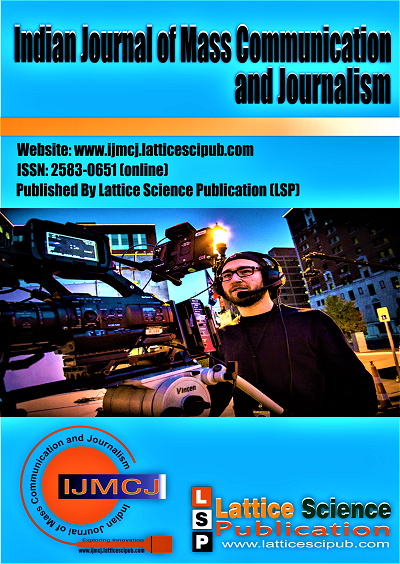From Nehru to Modi: Understanding the History of Indian Television Through a Post-Development Lens
Main Article Content
Abstract
Digital India, the government’s flagship programme, at first glance is a radical departure from the past and a welcome step forward to digitise the country’s faltering infrastructure. However, as this chapter argues, seen through a post-development lens, the launch of Digital India can also be seen as a continuation of past governmental policies that hark back to the era of India’s first Prime Minister and the continuation of such programmes thereafter, policies which used the medium of mass media ostensibly as a tool for development but ultimately as a mechanism of control. From the beginnings of television history in India and tracing its growth, this chapter shows that the policies of the present government, has its echoes in the past and development is still the rhetoric used to control the country’s increasing population.
Downloads
Article Details

This work is licensed under a Creative Commons Attribution-NonCommercial-NoDerivatives 4.0 International License.
How to Cite
References
https://www.digitalindia.gov.in/
https://newint.org/features/1992/06/05/keynote
Batabyal, Chowdhy, Gaur and Pohjonen, Indian Mass Media and the
Politics of Change. (Routledge, 2011)
Sachs, W. The Development dictionary: a guide to knowledge as
power. (Zed Books, 1992)
https://www.trumanlibrary.gov/library/public-papers/19/inauguraladdress
Schramm, W. Mass media and national development; the role of
information in the developing countries. (Stanford University Press,
chromeextension://efaidnbmnnnibpcajpcglclefindmkaj/https://openaccess.cit
y.ac.uk/id/eprint/12164/1/American%20Jnl%20of%20Economics%2
and%20Sociology-article-IP-CC%20(2).pdf
Need a 2005 ref
Batabyal, Chowdhy, Gaur and Pohjonen, Indian Mass Media and the
Politics of Change. (Routledge, 2011)
https://www.youtube.com/watch?v=D9Ihs241zeg&ab_channel=TED
Corbridge, S. The political economy of development in India since
independence in Brass, P (ed.) Routledge Handbook of South Asian
Politics: India, Pakistan, Bangladesh, Sri Lanka, and Nepal. 318-336
(Routledge. 2009)
https://www.newyorker.com/magazine/2015/06/29/the-great-dividebooks-dalrymple
Dreze, J., & Sen, A. An uncertain glory: India and its contradictions.
(Allen Lane.2013). [CrossRef]
Rao, VKRV. Reflection on Economic Policies in the PostIndependence India. The Indian Economic Journal. 56(2):118-136.
doi:10.1177/0019466220080209 (2008) [CrossRef]
The ‘push from major cities’ to ‘smallest towns’ is a mirror image of
the two-step model in communication theory, and part of every primer
in development studies. In this model, it is implied that the ‘modern’
ideas that television and radio would bring into the Third world would
be overwhelming for its traditional citizens and the elites and the
literate of the society would have to step in, understand the information and then interpret it for their fellow
citizens to be able to cope with. Here, the ‘disruption of the
established ways of life’ would be easier for cities to cope with before
it can travel towards hinterlands.
Guha, R and Martinez-Alier, J. Varieties of environmentalism: Essays
North and South, (Oxford University Press, 1998)
Shitak, S. S. Television and Development Communication in India: A
critical Re-appraisal, Global Media Journal – Indian Edition/ISSN
-5835 Winter Issue, Vol. 2/No.2 (2011)
Mehta, N. Television in India: satellites, politics and cultural change.
(Routledge, 2008).
Kumar, S. Gandhi meets primetime: globalization and nationalism in
Indian television. (University of Illinois, 2006)
Shitak, S. S. Television and Development Communication in India: A
critical Re-appraisal, Global Media Journal – Indian Edition/ISSN
-5835 Winter Issue, Vol. 2/No.2 (2011)
Page, D., & Crawley, W. Satellites over South Asia: broadcasting,
culture, and the public interest. (Sage Publications, 2001).
Singhal, A, & Rogers, Everett M. India’s Communication Revolution:
From Bullock Carts to Cyber Marts. (Sage Publications, 2001).
Shitak, S. S. Television and Development Communication in India: A
critical Re-appraisal, Global Media Journal – Indian Edition/ISSN
-5835 Winter Issue, Vol. 2/No.2 (2011)
Agrawal, B.C., & Raghaviah, S. India: Public Service Broadcasting
and changing perspectives in Banerjee, I., & Seneviratne, K. (Eds.),
Public Service Broadcasting in the Age of Globalisation Singapore:
Asian Media Information and Communication Centre. 149-14 (2006).
Singhal, A, & Rogers, Everett M. India’s Communication Revolution:
From Bullock Carts to Cyber Marts. (Sage Publications, 2001).
Thomas, P.N. Political Economy of Communications in India: The
Good, the Bad and the Ugly. (Sage Publications, 2010). [CrossRef]
A much diluted Prasar Bharati Bill would be enacted in 1997
Mehta, N. Television in India: satellites, politics and cultural change.
(Routledge, 2008).
Mehta, N. Television in India: satellites, politics and cultural change.
(Routledge, 2008).
Ghose, B. Doordarshan Days, (Penguin, 2005)
Anderson, B. R. O. Imagined communities: reflections on the origin
and spread of nationalism. (Verso Books, 2016).
Appadurai, A. Modernity at Large (Routledge, 1996)
Mehta, N. Television in India: satellites, politics and cultural change.
(Routledge, 2008).
Rajagopal, A. Politics after Television: Religious Nationalism and the
Reshaping of the Indian Public, (Cambridge University Press. 2001)
[CrossRef]
Mehta, N. Television in India: satellites, politics and cultural change.
(Routledge, 2008).
Mehta, N. Television in India: satellites, politics and cultural change.
(Routledge, 2008).
Shah, A. Telly-Guillotined : How Television Changed India. (Yoda
Press, 2019)
Page, D., & Crawley, W. Satellites over South Asia: broadcasting,
culture, and the public interest. (Sage Publications, 2001).
Ganguly, M., and Ganguly, B. in “Prasar Bharati Bill: Critical
Assessment.” Economic and Political Weekly 25, no. 10 484–88
(1990)
Page, D., & Crawley, W. Satellites over South Asia: broadcasting,
culture, and the public interest. (Sage Publications, 2001).
Page, D., & Crawley, W. Satellites over South Asia: broadcasting,
culture, and the public interest. (Sage Publications, 2001).
Page, D., & Crawley, W. Satellites over South Asia: broadcasting,
culture, and the public interest. (Sage Publications, 2001).
Batabyal, S. Making news in India: Star news and Star Ananda
(Routledge, 2012)
Kumar, S. Digital Television in Digital India in (pg 53-75) in
Punthambekar, A., and Mohan, S. eds. Global Digital Cultures:
Perspectives from South Asia. (University of Michigan Press, 2019).
Yeo S. Book review: The History of the International
Telecommunication Union (Itu): Transnational Techno-Diplomacy
from the Telegraph to the Internet. Global Media and
Communication.18(1):149-151. (2022)
https://www.cnet.com/tech/services-and-software/exclusive-itufailed-says-former-policy-chief/
https://www.itu.int/pub/D-IND-ICTOI-2012
Padmanabhan, A. “Digital Dividend: Framing the Problem.” Carnegie
India, November 1. https://carnegieindia.org (2016)





